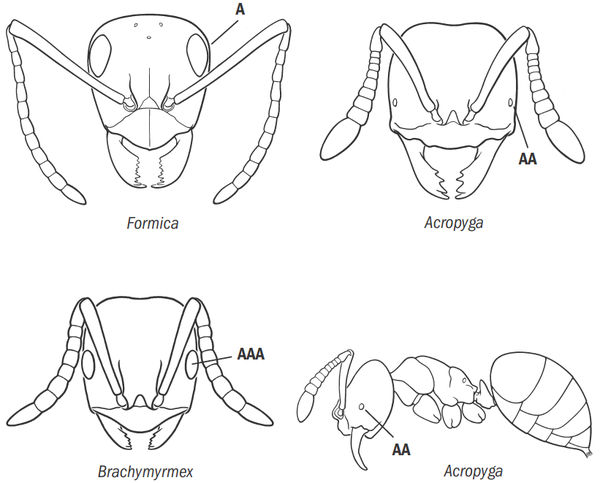Key to North American Genera of Formicinae
This key to the genera of North American Formicinae has been adapted from Fisher & Cover (2007).
1
- Antenna 12-segmented, eyes well developed (A). (commonly collected) => 2
- Antenna 10- or 11-segmented. Eye minute, nearly vestigial (AA). (Not commonly collected, Arizona) => Acropyga (Acropyga epedana)
- Antenna 9-segmented, eyes well developed (AAA). (Not commonly collected outside southeastern North America) => Brachymyrmex
2
- Antennal sockets located well behind the posterior clypeal margin (A). Acidopore lacking fringe of erect hairs. Mesosomal profile often continuous and convex. Metanotal suture rarely impressed (B) => Camponotus
- Antennal sockets situated at or adjacent to posterior clypeal margin (AA). Acidopore with circular fringe of erect hairs. In profile, propodeum distinctly depressed below level of promesonotum and metanotal suture always impressed, forming a transverse groove across mesosomal dorsum (BB) => 3
3
- Mandible long and sickle-shaped, with minutely serrate inner margin but lacking dentate cutting margin (A). Reddish. (Not commonly collected) => Polyergus (Species key)
- Mandible not long, approximately triangular, with oblique or transverse multidentate cutting margin (AA). Color variable => 4
4
- Maxillary palpi greatly elongated, segment 4 much longer than 5 + 6 (A). Psammophore frequently present (B) => Myrmecocystus (Species key)
- Maxillary palpi normal to very short, segment 4 (when present) no longer than 5 + 6 (AA). Psammophore absent, although short erect hairs may be present on ventral surface of head => 5
5
- Mandibles with seven or more teeth or denticles. Dorsum of propodeum often longer than posterior face (declivitous face) (A), or propodeum evenly rounded with faces not distinguishable. Ocelli present and well developed (B). Propodeal spiracle elliptical to broadly oval => Formica (Key to F. pallidefulva group, F. rufa group)
- Mandibles with five or six teeth or, if seven or more, then dorsum of the propodeum is notably shorter than the posterior surface (declivitous face) (AA). Ocelli very small (e.g., Paratrechina longicornis) or absent. Propodeal spiracle circular to subcircular => 6
6
- Antennal scape surpassing posterior lateral margin of head (if at all) by less than one third of its length (A). Pronotum without black coarse hairs but with pilosity that is long or short and often golden in color (B). Mandibles with seven to eight teeth or denticles => Lasius
- Antennal scape usually surpassing posterior lateral margin of head by at least one third of its length, sometimes more (AA). Erect hairs on dorsum of pronotum either coarse, long and black or brown, or fine and golden in color (BB). Mandibles with five or six teeth => 7
7
- Mesosoma, in dorsal view, strongly constricted immediately behind pronotum (A). Erect hairs on mesosomal dorsum slender, golden or brownish, not coarse and bristle-like, not occurring in pairs on the mesosomal dorsum (B). Scape and tibia lacking erect hairs (short pubescence present). With head in full-face view, most or all of eye posterior to middle of sides (C) => Prenolepis (Prenolepis imparis)
- Mesosoma, in dorsal view, only slightly constricted immediately behind pronotum (AA). Erect hairs on mesosomal dorsum coarse, bristle-like, often dark brown or black, occurring in pairs on the mesosomal dorsum (BB). Scape and tibiae often with erect hairs. With head in full-face view, most or all of eye at or anterior to middle of sides (CC) => 8
8
- Mandibles with five teeth => Paratrechina (Paratrechina longicornis)
- Mandibles with 6 or 7 teeth => Nylanderia (Species key)
References
- Fisher, B. L.; Cover, S. P. 2007. Ants of North America. A guide to genera. Berkeley: University of California Press, xiv + 194 pp.






